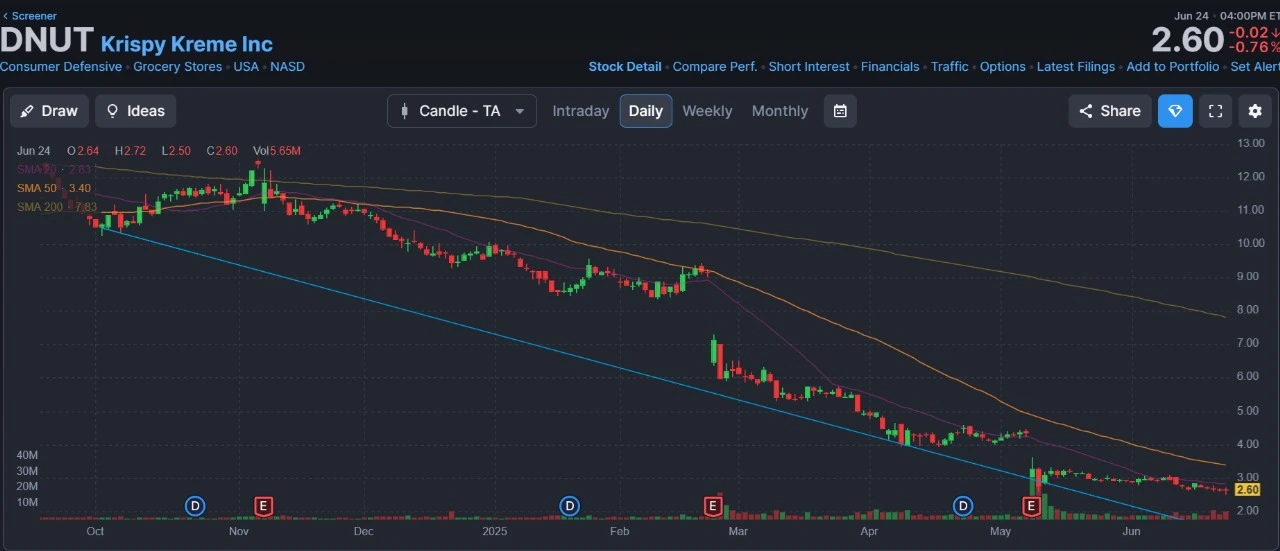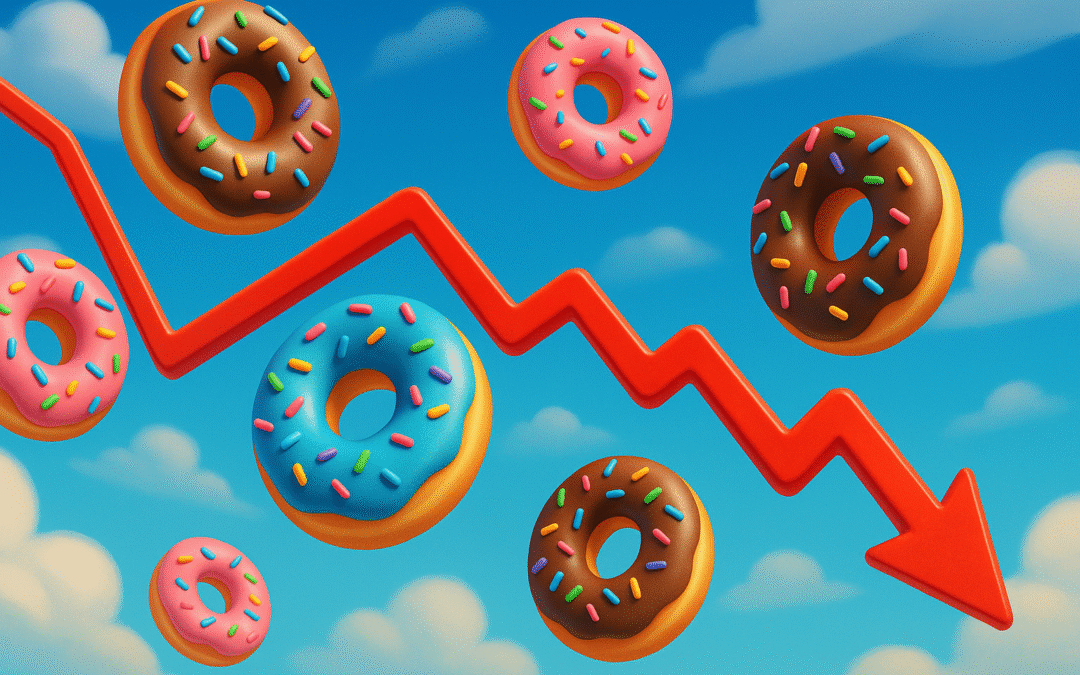The Sweet Start That Got Everyone High on Glaze
Back in the early 2000s, Krispy Kreme was more than a donut shop. It was an event. People lined up outside stores just to see the red neon “Hot Now” sign flicker on. That glow signaled more than a pastry, it symbolized warm comfort, sugar-dusted joy, and a shared obsession.
But good things don’t always stay hot.
After a botched early 2000s IPO and a long period in the financial wilderness, Krispy Kreme returned to public markets in July 2021. Listed under the ticker DNUT, it was framed as a nostalgic comeback with modern ambition.
Investors were intrigued. The brand held strong recognition. Its product — donuts — were considered recession-proof comfort food. The market saw DNUT as an opportunity to ride the pandemic-era wave of consumer brand loyalty, just like what happened with Crocs or Coca-Cola.
On day one, the IPO raised nearly $500 million. The price? $17 per share.
But what seemed hot out of the fryer slowly started to cool.
A Revival Full of Holes
Krispy Kreme didn’t just want to return. It wanted to transform.
This wasn’t about opening more donut shops and calling it growth. Leadership envisioned a bold new business model: one that could scale rapidly without opening thousands of traditional stores. They called it the hub-and-spoke system — a logistics-driven network where large, centralized production hubs would bake the donuts and distribute them to a wide array of “spoke” locations.
These spokes weren’t limited to Krispy Kreme outlets. The idea extended to gas stations, convenience stores, supermarkets, and even fast food chains. In theory, this setup allowed the company to reach millions of consumers daily without the overhead of a retail storefront.
On paper, the model seemed efficient. Less capex. More reach. But in reality, every additional spoke added complexity. Distribution costs ballooned. Maintaining freshness, consistency, and speed across so many different retail formats became a nightmare. What seemed lean turned out to be logistically exhausting and operationally expensive.
Then came the big swing: partnering with McDonald’s.
This was the moment everything was supposed to change. If successful, Krispy Kreme donuts would be sold in over 13,000 McDonald’s outlets across the U.S. That wasn’t just scale, that was saturation. A donut at every drive-thru. A brand that couldn’t be ignored.
Investors loved the story. Analysts bought in. The stock gained momentum. For a while, it felt like Krispy Kreme was finally rewriting its destiny.
But something important got lost in the sugar rush: the financials.
Under the surface, margins remained razor-thin. Debt kept mounting. Cash flow stayed negative. The company’s logistics infrastructure was being stretched to its limits, and profitability never materialized.
Yet the stock kept rising. Not because of numbers, but because of narrative. This wasn’t uncommon — many companies ride a hype cycle before they deliver results. The problem? Krispy Kreme never did.
And as Wall Street has learned time and again, stories without substance don’t last long.
The Financial Recipe Gone Wrong
Let’s break it down:
- Revenue (TTM): $1.66 billion
- Net Income: –$21.6 million
- EBITDA Margin: 0.92%
- Free Cash Flow: –$74.9 million
- Debt/Equity Ratio: 1.31
- Current Ratio: 0.35
DNUT was trying to scale a physical product, using a logistics-heavy model, during a time of inflation, labor shortages, and supply chain disruption. That’s not just a difficult task. It’s a setup for disaster.
Despite revenue growth, profits were elusive. And worse? The business was bleeding cash — and fast.
Investors ignored these red flags because of one thing: McDonald’s. The belief was that this one partnership could offset the operational inefficiencies and make the model profitable.
It was a bet. And like most hopeful bets, it didn’t pay off.
The McDonald’s Breakup – When Sweet Turns Sour
The partnership with McDonald’s was supposed to be Krispy Kreme’s defining moment, the sugar-coated masterstroke that would send its distribution model into overdrive.
The idea was simple: Krispy Kreme donuts would be available at McDonald’s outlets across the United States. That meant more than 13,500 locations, nearly overnight access to every drive-thru in America, and a dream opportunity for brand exposure that few food brands could ever buy.
From a branding standpoint, the deal looked golden. But financially, it turned into a powder keg.
For several quarters, management hailed the McDonald’s collaboration as a strategic win. Investors were told this rollout would validate the hub-and-spoke model. Analysts echoed the sentiment. Bullish price targets baked in assumptions that McDonald’s would drive significant revenue — even if the margin profile wasn’t perfect. On the surface, the numbers seemed promising. Same-store sales got a temporary lift. Investor sentiment stayed sticky and sweet.
But inside the system, operational chaos was brewing.
Unlike burgers or fries, donuts don’t have long shelf lives. Krispy Kreme committed to delivering fresh donuts — often multiple times a day — to each McDonald’s location participating in the pilot. This wasn’t a frozen product. It was perishable, delicate, and required just-in-time logistics.
Soon, the cost of freshness started weighing heavily. Fleet expenses surged. Labor became stretched. Delivery schedules became a juggling act. Franchisee feedback was mixed at best. And McDonald’s — a company known for relentless supply chain efficiency — didn’t like what it saw.

On June 24, 2025,
The announcement came like a stomach punch: McDonald’s and Krispy Kreme would end their U.S. donut pilot partnership. Both companies cited rising operational costs and scalability concerns.
DNUT stock reacted violently. It dropped more than 20% by market close, continuing its downward trend over the following days. Shareholders weren’t just responding to the loss of potential revenue — they were reacting to the collapse of a central pillar in Krispy Kreme’s strategy.
Worse, this wasn’t a typical “missed guidance” moment. It was a credibility blow. For over a year, Krispy Kreme had pitched its model around this exact partnership. Now, it looked like that model couldn’t handle real-world volume.
The mood on Wall Street shifted quickly. Analysts downgraded the stock en masse. Firms that had previously seen long-term upside turned bearish. Price targets got slashed by half — some even more.
Retail investors, many of whom had stuck around for the comeback story, felt blindsided. Social media buzz flipped overnight from enthusiastic to accusatory.
The McDonald’s breakup didn’t just hurt earnings projections. It unraveled trust.
And for a brand that was trying to re-glaze its Wall Street reputation, that trust might have been the most important ingredient of all.
The Hangover Hits — DNUT’s Freefall and the Narrative Collapse
When the McDonald’s breakup became public, the stock didn’t just dip. It cratered.
Within hours, DNUT dropped over 25%, wiping out hundreds of millions in market cap. The decline wasn’t just technical — it was emotional. For investors who had held on through years of promise, partnerships, and donuts-for-breakfast dreams, this moment felt like betrayal. A strategy that was once hailed as “disruptive distribution” had become too expensive to sustain. And Wall Street wasn’t in the mood for excuses.
A Quick Glimpse at the Carnage
Let’s look at the damage.
- Year-to-date performance: –73.82%
- 1-year decline: –77.07%
- Peak to current price: Down from $17+ to under $3
- Short interest: Spiked to over 29% of float
- Institutional holding: Began thinning out by Q2 2025
These numbers aren’t just red, they’re radioactive. Investors didn’t wait around to see if a turnaround was coming. They ran.
The Analysts Who Once Believed? They Turned
Before the fallout, several analysts had rated Krispy Kreme as a Buy or Outperform, based on the potential of its expanding retail footprint. That optimism vanished almost overnight. Coverage turned cautious. JPMorgan downgraded it to “Neutral.” RBC called the cost structure “unsustainable.” Morgan Stanley simply dropped coverage.
Even more telling? Price targets were slashed in unison. What once averaged around $10–11 collapsed to a $3.50–4.00 range, and some bearish estimates even suggested $1.80 as fair value if no growth strategy replaced the McDonald’s deal.
The Retail Crowd Finally Gave Up
Retail investors tend to hold onto hope longer than institutions. But this time, they let go.
Popular Reddit threads that once tracked DNUT’s expansion play-by-play turned eerily quiet. Finfluencers who had hyped the IPO were either silent or deleting past posts. Robinhood charts showed a steep decline in holding concentration. The DNUT hype cycle, once loud and sugary, had melted.
Investor sentiment hit rock bottom. And when confidence goes, it doesn’t walk out — it runs.
From “Hot Now” to “Not Now”
What makes this story sting is that it wasn’t an overnight disaster. DNUT didn’t collapse because of fraud or scandal. It collapsed because the story stopped working.
Krispy Kreme relied heavily on narrative. A legacy brand reborn. A massive retail deal. A scalable model. But all of it had to translate into profitability — and that’s where it failed.
As each quarterly earnings call brought more losses and less clarity, belief faded. The breakup with McDonald’s was simply the last straw.
What Went Wrong — Lessons from a Business That Couldn’t Scale
Krispy Kreme had a solid product. The donuts still tasted great. The brand recognition hadn’t faded. Yet none of that mattered when the economics didn’t make sense.
The first major flaw? The hub-and-spoke model, while innovative on paper, came with brutal costs. Centralized baking meant each location relied on daily shipments. That created massive pressure on logistics.
Fuel prices surged. Labor costs rose. Delivery routes got crowded. Every additional location didn’t bring economies of scale — it brought more expense. Unlike Starbucks or Dunkin’, Krispy Kreme couldn’t rely on high-margin coffee sales to balance the books.
The second problem? No pricing power. Unlike boutique donut shops or premium food brands, Krispy Kreme didn’t have enough leverage to raise prices. Supermarkets and McDonald’s weren’t going to pay more, and the brand couldn’t afford to alienate customers with higher retail prices either.
Meanwhile, debt kept mounting. The Debt-to-Equity ratio stood above 1.3. Free cash flow remained negative. Profitability metrics like EBITDA margin and ROIC were underwhelming, and interest coverage stayed dangerously low.
So what happened?
DNUT failed not because people stopped loving donuts — but because operationally, the business became too expensive to grow.
Compare this to Dunkin’ Brands, now under Inspire Brands. Dunkin’ focused on franchising, lowering operating risk. It built a lean supply chain and targeted volume with margin. Starbucks, on the other hand, monetized premium coffee culture and digital loyalty. Krispy Kreme lacked both the pricing power of Starbucks and the franchise model of Dunkin’.
Even companies like Shake Shack and Chipotle, while facing their own cost issues, relied on strong unit economics. Krispy Kreme didn’t. Each unit was a liability unless fully optimized — and that optimization never came.
In hindsight, the company expanded too fast, bet on the wrong distribution strategy, and didn’t listen to what the numbers were screaming early on.
The Final Glaze — What’s Next for DNUT and What Investors Can Learn
So, where does Krispy Kreme go from here?
First, let’s be honest. A turnaround is possible, but not probable without radical changes. The core product still has demand. People love the brand. But the company must reinvent how it delivers and monetizes that love.
Franchising more locations and reducing capital expenditure would be a start. Focusing on profitable markets, downsizing money-losing distribution hubs, and reworking labor-heavy supply chains could also help. DNUT must pivot from scale obsession to efficiency.
Next, communication matters. Investors aren’t allergic to risk — they just want clarity. Transparency about unit-level economics, profit centers, and debt plans would go a long way in rebuilding trust.
Additionally, DNUT could explore tech upgrades. A better loyalty app, digital ordering, and dynamic pricing could improve margins without sacrificing volume. It’s not about selling more donuts — it’s about selling smarter.
From an investor standpoint, Krispy Kreme serves as a case study. A reminder that brand love doesn’t pay the bills. Cash flow does. High hopes must be balanced with hard math.
For now, DNUT remains a highly speculative bet. The upside exists, but only if leadership demonstrates operational discipline and proves the model can generate real returns. Otherwise, the story stays broken.
Final word? Krispy Kreme may still warm hearts. But until it fixes its financial recipe, it won’t be warming investor portfolios anytime soon.
Disclaimer: This article is an analysis and opinion piece and should not be taken as financial advice. Always conduct your own research or consult a financial professional before investing.

